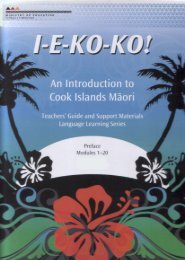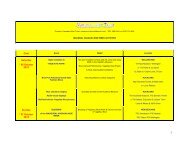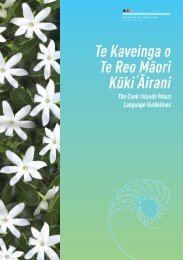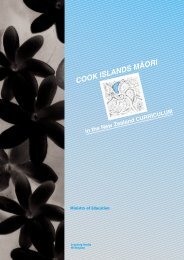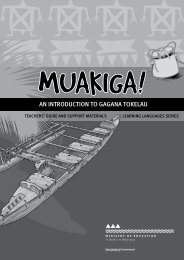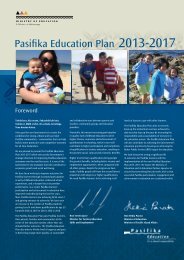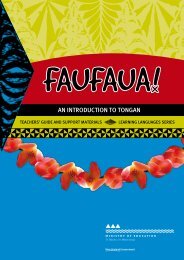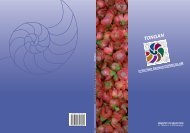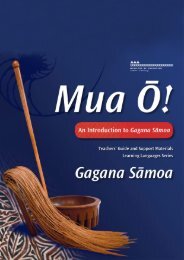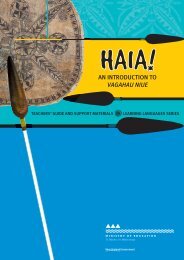Ta'iala mo le Gagana SÄmoa - Pasifika Education Community
Ta'iala mo le Gagana SÄmoa - Pasifika Education Community
Ta'iala mo le Gagana SÄmoa - Pasifika Education Community
Create successful ePaper yourself
Turn your PDF publications into a flip-book with our unique Google optimized e-Paper software.
Ālāfua 4 – Feso‘ota‘igaStrand 4 – CommunicationThe languages and symbols of their own and other cultures are pro<strong>mo</strong>ted and protected.During these early years, children are <strong>le</strong>arning to communicate their experience in many ways, and theyare also <strong>le</strong>arning to interpret the ways in which others communicate and represent experience.Te Whāriki, page 72SiniGoalsFa‘ata‘ita‘iga o tomai i <strong>le</strong>i‘uga ‘ua a‘oa‘oinaExamp<strong>le</strong>s of <strong>le</strong>arning outcomesFa‘ata‘ita‘iga o <strong>le</strong> poto māsani ‘uaa‘oa‘oinaExamp<strong>le</strong>s of <strong>le</strong>arning experiences32Goal 1Children experiencean environmentwhere theydevelop non-verbalcommunicationskills for a range ofpurposes.Children develop:• an increasingly elaboraterepertoire of gesture andexpressive body <strong>mo</strong>vementfor communication, includingways to make requests nonverballyand appropriately;• an increasing understandingof non-verbal messages …;• an ability to express theirfeelings and e<strong>mo</strong>tions in arange of appropriate nonverbalways.Children have opportunities to use gaganaSā<strong>mo</strong>a when they are:• using body language to express their needs,for examp<strong>le</strong>, pointing to food, toi<strong>le</strong>t, books,or sink;• waving hands to show direction, for examp<strong>le</strong>,to indicate sau (come here);• nodding their head to show agreement;• engaged in imaginative play activities, forexamp<strong>le</strong>:Child 1: ‘O a‘u Mummy, ‘o ‘oe Dad.Child 2: ‘Ia vili mai <strong>le</strong> te<strong>le</strong>foni;• bending forward to lower their body whenwalking in front of peop<strong>le</strong> (whi<strong>le</strong> also sayingtulou);• sitting on the floor with <strong>le</strong>gs folded;• sitting down in preparation for eating ordrinking.Goal 2Children experiencean environmentwhere theydevelop verbalcommunicationskills for a range ofpurposes.Children develop:• language skills in real,play, and prob<strong>le</strong>m-solvingcontexts as well as in <strong>mo</strong>restructured language contexts,for examp<strong>le</strong>, through visualmedia;• language skills for increasinglycomp<strong>le</strong>x purposes, such asasking about intentionsand feelings, negotiating,predicting, planning, guessing,and story-telling;• confidence that their firstlanguage is valued.Children have opportunities to use gaganaSā<strong>mo</strong>a when they are:• <strong>le</strong>arning a new song, for examp<strong>le</strong>, Tālofa lavalava lava;• <strong>le</strong>arning or reciting a rhyme, for examp<strong>le</strong>,Le lima tamatama, Le lima tu‘umama …;• giving and following instructions whenplaying;• hearing gagana Sā<strong>mo</strong>a used as the languageof instruction, for examp<strong>le</strong>, an adult may say:Tālofa, [name of child], ‘o ā mai ‘oe?Manuia fa‘afetai. Savali lēmū, ‘ia fa‘aeteetene‘i ‘e sulu;• conversing with teachers, parents, and otherchildren in gagana Sā<strong>mo</strong>a, for examp<strong>le</strong>, attala fou (news time):Child: Sā fai <strong>le</strong> fa‘aipoipoga ‘a lo mātou‘āiga ananafi.Teacher: Sapi manatua mai lou ‘ofutā‘e<strong>le</strong> taeao;• having their first language affirmed, if it isnot gagana Sā<strong>mo</strong>a, for examp<strong>le</strong>, by beinggreeted in their language.



